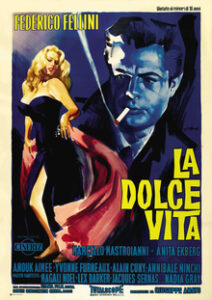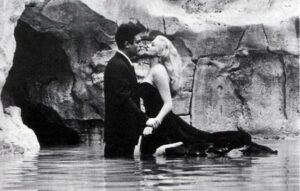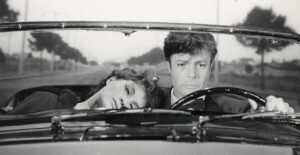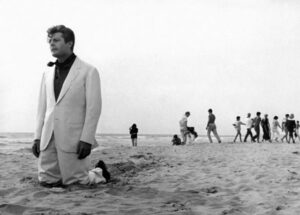“La Dolce Vita” – at the Bottom of Hell

Title: “La Dolce Vita”
Release Date: 1960
Director: Federico Fellini
Cast: Marcello Mastroianni, Anita Ekberg, Anouk Aimee, Yvonne Furneaux, Magali Noel
“They say the world is beautiful, but how can it be beautiful when all it takes is the push of one button and everything turns into chaos” – says one of the characters in “La Dolce Vita”. Fellini’s work is a meticulous and pessimistic study of this chaos, which can be called the hell of human existence.
“La Dolce Vita”
“La Dolce Vita”, made by Federico Fellini in 1960, gained unheard-of fame right after its appearance on the big screen, among others thanks to the stigma of scandal. The director was accused of the worst inclinations – he decided to show the world of the elite in the worst light. The work was even read as a film with a key, looking for features of real characters from the front pages of newspapers in individual characters. The main character himself bears clear autobiographical traits – for he is a young journalist, Marcello (played by Marcello Mastroianni), who comes from a provincial town to Rome to make a big career. Fellini also started out as a journalist, and his path to fame was opened by his collaboration with Roberto Rossellini.
The time of the plot “La Dolce Vita” covers a week in the life of Marcello Rubini, who works in one of Rome’s tabloids and specializes in providing viewers with the spiciest details of celebrities’ lives. The journalist works with an inseparable photographer named Paparazzo – interestingly enough, it gave rise to the usual name of the profession of paparazzis, lurking in the privacy of celebrities. The world of people completely free of material worries fascinates Marcello more and more; it appears as the title “la dolce vita” – “the sweet life”. As the journalist enters into the secrets of this world, so far closed off to him, it turns out that this paradise also has another, much darker side. However, Marcello is so intoxicated by the atmosphere of constant partying that he can’t get out of this environment, even though he really wants to. He cheats on his girlfriend Emma with a succession of random society women, and finally he ruthlessly abandons her and indulges in orgiastic pleasures.

“La Dolce Vita” – Rome as a city of universal symbols
In “La Dolce Vita” Fellini very interestingly builds the space, which becomes an important component of the film’s message. Obviously, the work is a wonderful portrait of Rome – the eternal city; the director tries to show it in all its splendour. What is more, due to its history, Rome becomes a miniature of the world, a universal space. Elements of the sacred and the profane intermingle here – on the one hand we see the Vatican, the very heart of Catholicism, and on the other hand the nightclubs in Via Vittorio Veneto, where the spiciest entertainment can be found. There is also the magnificent Trevi Fountain, where the famous dance scene of the American film star, the beautiful Silvi, takes place. Fellini also does not forget about the ancient face of the eternal city – in the first scene of the film we see the ancient ruins of the Roman Forum.
However, Fellini’s Rome is not only a collection of postcard images, as the director constructs the protagonist of “La Dolce Vita” in such a way that he becomes a guide of the viewer around the Italian capital and shows us also the less known face of the city. We often see Rome at night, we enter small, unknown streets together with Marcello, we find ourselves in poor districts or even in the middle of poverty. For example, in one of the first scenes of the film, Marcello and his wealthy lover decide to have sex in the bed of a prostitute living in a squalid, moldy basement.

“La Dolce Vita” – a contemporary morality play
In “La Dolce Vita” Fellini builds the world on the principle of contrast, which results in the peculiar symbolism of the film. On the one hand, there is the church and the ordinary house, and on the other hand, seatings nightclubs, exclusive interiors and castles where orgies take place. It is thus a symbolic meeting of wealth and poverty, holiness and sin, and art and kitsch. Between these two worlds there is Marcello whose soul, like in a medieval morality play, is being fought over by the forces of good and evil. The young journalist is completely torn – he can’t decide whether he wants to spend his life with Emma, who loves him, or avoid commitments and enjoy the charms of many wealthy mistresses. He also wants, like his friend Steiner, to be a writer and create great works, but on the other hand he is attracted to the world of empty journalism, offering big money in exchange for the pursuit of cheap sensation.
Fellini seems to lay out the values clearly. “La Dolce Vita” is certainly a terrifying picture of the inner emptiness of the elite: stars, directors, aristocracy, wealthy industrialists, that is people who, deprived of ordinary cares, try to kill the boredom of their existence by the most perverse activities. This world of constant entertainment is completely devoid of love, on the surface glitters with glamour, but deep down shocks with corruption. As one of the characters says after a night of orgy – “I had on beautiful makeup, but now I feel dirty”. This is the reality of hell – total chaos and lack of human feelings. Fellini clearly introduces the symbolism of inferno in the film: the night, the underworld, the summoning of ghosts and the devilish eyes of one of Marcello’s lovers. Unfortunately, whoever comes into contact with this reality is appropriated by it and becomes its slave.

“La Dolce Vita” – the Other Face of Marcello
Nevertheless, the most mysterious character in “La Dolce Vita” is not Marcello but his friend Steiner. The writer, who often hosts great artists – poets, painters, musicians – leads an exemplary life: he is a Catholic, has a wife and two children whom he loves very much. However, one day he unexpectedly murders his daughter and son, and then commits suicide. The character of Steiner can be interpreted as an alternative version of the main character. He leads exactly the life of a journalist until he enters the dark world of the “sweet life” of the cream of Rome’s society. Moreover, we are dealing with a peculiar way of filming this character – in one of the most significant scenes he is shown twice – thanks to the reflection in the glass. Thus, Steiner’s murder and suicide can be interpreted as a symbolic act of Marcello’s abandoning his old dreams.
This is especially indicated by the enormous transformation of the protagonist after the suicide of his friend – contrary to the expectations of the viewer, instead of returning to the right path after the shock, the journalist finally sinks into corruption. It is significant, however, that paradoxically Steiner (Marcello) kills his children out of love – he fears for their future, because he realizes that the world is a hell which constantly lurks in wait for human happiness. By giving up his family, Marcello spares them from suffering. He himself has very difficult childhood experiences, his father never took care of him, and when he meets him years later, he is a complete stranger.
“La Dolce Vita” – culture versus nature
In “La Dolce Vita” Fellini draws an extremely pessimistic vision of existence – what a man desires most becomes the source of his defeat, and the sweet life turns into a life in hell. However, at the same time, there are elements of hope in this work, which is situated in the spheres of nature, faith, and art. The city, the space of culture, is clearly contrasted here with the space of nature. In the last scene of the film, after a night orgy, Marcello goes to the sea. The murmur of the waves and the infinity of the horizon are a solace for his senses and soul. Moreover, water is a symbol of purification. On the shore, on the other side of the bay, there is a young girl – but Marcello does not understand her gestures and words. For the girl is a symbol of innocence irretrievably lost. Instead, on his shore, there is a dead sea monster, a sign of moral corruption.

